Pasta is quite possibly one of the world’s favorite comfort foods. Its versatility lends it to a variety of dishes, from sauce-based recipes to soups and salads. Pasta comes in all types of shapes and sizes, but did you know each shape serves a purpose? Learn more about the different varieties of pasta and when you should use them.
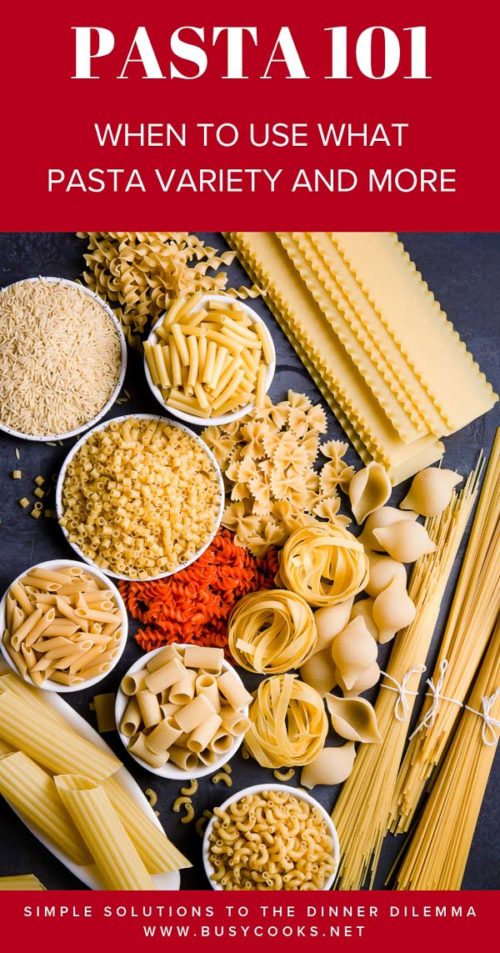
Dried Pasta vs. Fresh Pasta
There is nothing quite like the luxurious taste and texture of fresh pasta. However, using fresh pasta isn’t always practical for every recipe.
Dried pasta is made with more flour, therefore its texture is more dense. It holds up better with thick sauces or in a baked casserole. Dried pasta is shelf stable and will keep for years in your pantry.
Fresh pasta contains more egg and water. It has a delicate texture and should be paired with light sauces. Fresh pasta cooks in half the time of dried, so be mindful of your time and don’t overcook. In addition, fresh pasta must be kept in the refrigerator and used within a few days.
Fresh pasta can be substituted for dried pasta in certain recipes. Just keep in mind, you will need more fresh pasta to yield the same amount. One pound of dried pasta yields the same as 1 1/2 pounds of fresh pasta.
What is Pasta Made of?
Most pasta is made from either semolina or durum flour. Both types of flour are milled from durum wheat. However, semolina is more coarsely ground, giving it a heavier texture. It’s used for making pasta that needs to hold a certain shape, such as macaroni.
Durum flour is finely ground and has a lighter texture. It’s used for making certain types of noodles, such as spaghetti or lasagna noodles. This allows the noodles to become more pliable during cooking.
There are other types of varieties available such as whole grain pasta which is made from wheat flour, rice noodles, and soba noodles made from buckwheat flour. Gluten free pasta may be made with corn meal.
Pasta Varieties
Long pasta noodles
- Spaghetti – probably the most well-known type of pasta. Spaghetti works well for thick or thin pasta sauces and in hot or cold recipes. It’s usually boiled first, but once cooked it can also be used in baked pasta recipes. This 20-minute fresh cherry tomato pasta is perfect for spaghetti!
- Angel hair – similar to spaghetti, only thinner. Perfect for light, simple sauces, like in this creamy white wine scallops pasta.
- Fettuccine – flat thick pasta used with cream-based sauces such as alfredo sauce, like in this irresistible 30-minute smoked salmon fettuccini alfredo.
- Lasagna – wide flat pasta sheets usually layered with sauce and cheese to make the dish
- Linguini – flat thick pasta similar to fettucine but not as wide. Works well with oil-based sauces or paired with a protein such as chicken or fish. This quick and easy chicken breasts with creamy white wine sauce is ideal served over linguini.
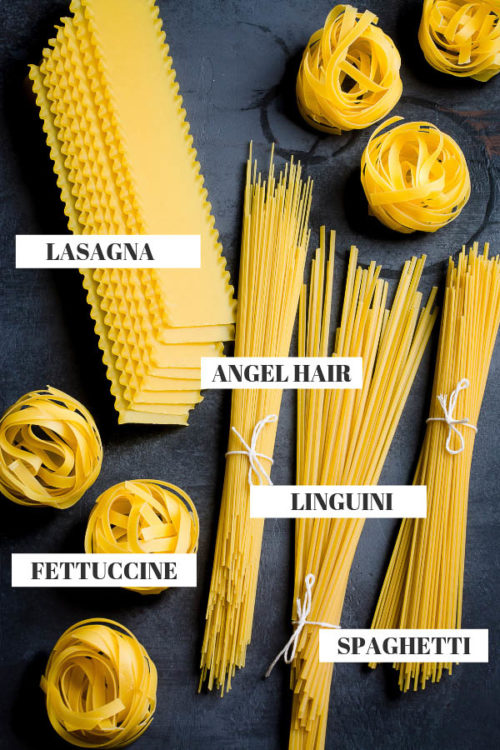
Short pasta noodles
- Shell pasta – these are also referred to as conchiglie. Its shell-like shape allows it to hold up well in heavy meat sauces, cheese sauces, or in cold pasta salads. It comes in small, medium and large varieties. The largest shape, conchiglioni, can be stuffed with cheese or other ingredients and baked. You can also cook stuffed shells in an Instant Pot.
- Corkscrew pasta – Also known as rotini, these curly-cued pastas hold sauce well, making them perfect for everything from rich tomato sauces to cream sauce, baked dishes and pasta salads.
- Bow shaped pasta – you may also see these referred to as farfalle. This dense pasta is great for sauce dishes, dishes paired with a protein, baked casseroles and pasta salads.
- Egg noodles – egg noodles are used in a wide variety of ethnic European cuisines. They are great in soup, as a side dish or baked in a casserole.
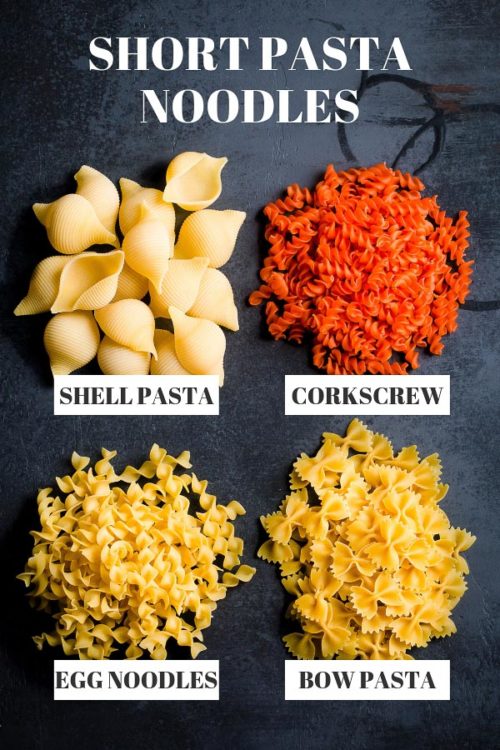
Tubular pasta
- Manicotti – a large tubed shaped pasta with ridges on the outside. Manicotti is typically boiled first, then stuffed with meat or cheese and baked.
- Penne – these are medium sized tube noodles with angled edges. There’re 2 types of penne pasta: penne mostaccioli and penne rigate. Penne mostaccioli noodles are smooth and great in baked casserole dishes. And penne rigate has ridges on the outside, allowing it to hold sauce. It’s ideal for heavy sauces, pasta salads, or a pasta dish that will be served with a protein.
- Ziti – ziti is sometimes confused with penne. While both pastas look similar, ziti does not have ridges or the angled edges. However, they can be used interchangeable in many dishes. We’ve used ziti in our delicious Instant Pot Chicken Alfredo Pasta.
- Rigatoni – rigatoni is wider than ziti or penne, has ridges but no angled edges. Thay hold up well in heavy sauce recipes.
- Elbow macaroni – after spaghetti, elbow macaroni is the most well-known pasta shape. Its name comes from the curved shape of the noodle. While mac and cheese is the most popular elbow macaroni dish, it also works perfect in our homemade hamburger helper! Elbow macaroni also hold up well in baked casseroles, soups and pasta salads.

Small pasta
- Orzo – orzo looks like rice, but it’s actually a noodle. Use it in side dishes, soups or pasta salads.
- Ditalini – a tiny tube-shaped pasta used in soups, such as minestrone, and salads.
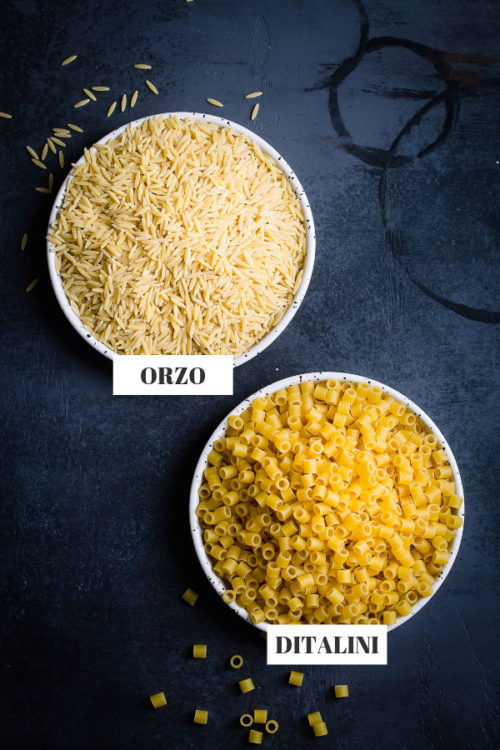
Stuffed Pasta
- Tortellini – ringed shaped pasta filled with meat, cheese or a combination of both. Tortellini pairs well with a variety of sauces from heavy tomato sauce to a light cream sauce, like in this Instant Pot Sun-Dried Tomato Chicken Tortellini. They can also hold their own when paired with a light oil-based sauce, used in soup or in a pasta salad.
- Ravioli – square or round pillow-shaped pastas traditionally stuffed with meat or cheese. However, ravioli can be stuffed with virtually anything your imagination can come up with. Like tortellini, ravioli can pair with either tomato or cream sauce. They are also delicious breaded and fried.
Pasta Storage
Dried pasta should be stored in its original unopened packaging on a shelf or in a cabinet until ready to use. Once the package has been opened, it’s a good idea to transfer any remaining dried pasta into an airtight container. If stored properly, dried pasta will keep for up to two years.
Uncooked fresh pasta needs to be stored in the refrigerator and used within four days. Fresh pasta can also be frozen for up to three months.
Cooked pasta should be transferred to an airtight container and stored in the refrigerator. If possible, store the cooked pasta and sauce separately, as the pasta will absorb any liquid in the sauce. Cooked pasta without sauce should last five days in the refrigerator. Freezing certain types of cooked pasta can change the texture of the noodle and is not recommended.
This article was written by Lisa Bynum for Busy Cooks.
Stay connected and join Busy Cooks community:
FACEBOOK | PINTEREST | INSTAGRAM
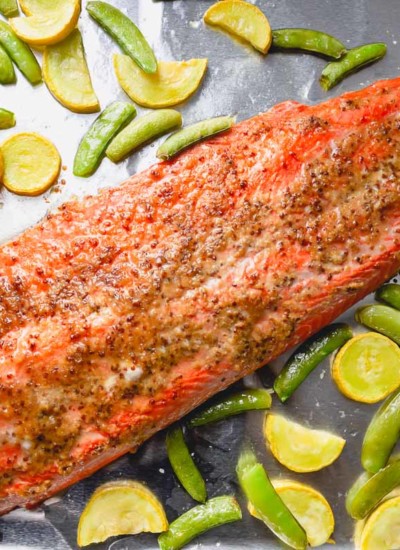
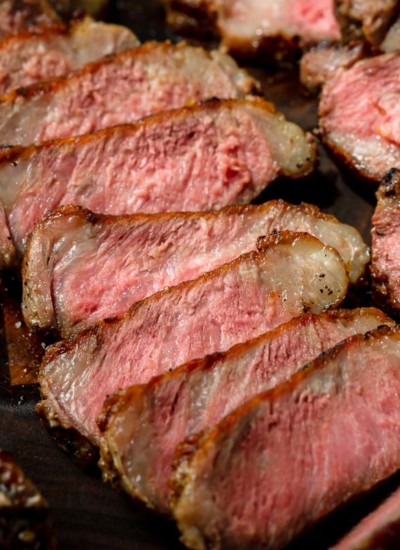
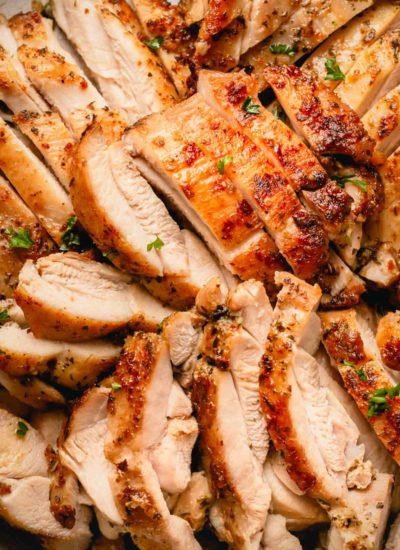
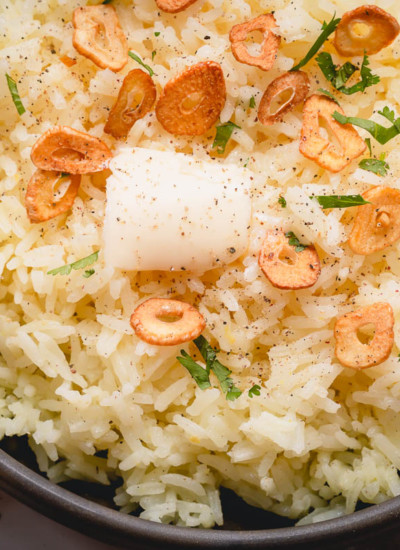

Comments + Reviews